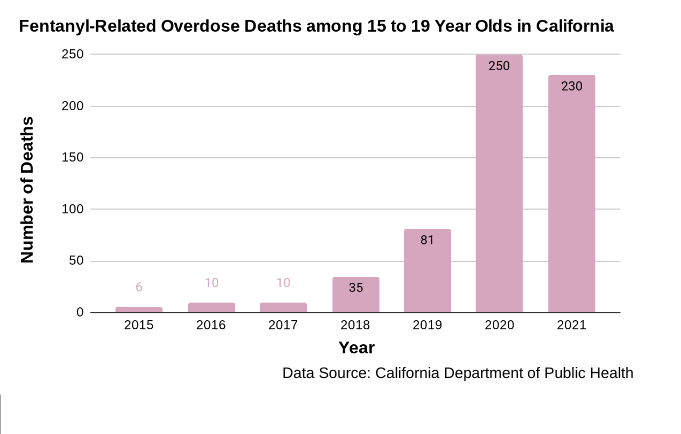In 2020 and 2021, one-fifth of deaths of Californians between the ages of 15 and 24 were caused by fentanyl, according to the Mercury News. Fentanyl is a cheap opioid that drug cartels are increasingly adding to other drugs, making these less powerful drugs more addictive and dangerous, according to the Mercury News.
Also referred to by the brand name Narcan, naloxone is the life-saving medication used in the case of a fentanyl overdose, MUSD Program Manager for Special Education and Student Services Jillian Valdez said. At MHS, Assistant Principals Jennifer Hutchison and Andrew Dinh, as well as Health Clerks Lea Labrador and Felicitas Dacanay are trained to administer naloxone, Valdez said.
“Through our county partnership, we will be receiving an allotment of naloxone for all of our campuses,” Valdez said. “It’ll be about 22 boxes, which is about 44 doses of naloxone for our high school.”
Additionally, the campus resource officers are trained to administer naloxone and have it in their possession, Assistant Principal Jennifer Hutchison said. The rest of the administration team also plan to be trained within the next few months, Hutchison added.
“We worked with the district and the district nurse so that all admin can get trained with Narcan,” Hutchison said. ”We all stay as up to date as we can with just all kinds of drug knowledge: what’s out there, what we’re seeing on campus, how it looks, and how we should move forward.”
In the case of a fentanyl overdose, a point person will assess the individual’s symptoms and 911 will immediately be called, Hutchison said. Since Hutchison oversees school safety, she would normally be the point person, but any member of school administration nearby would respond to the situation immediately, she added.
“If we determine that Narcan is our best response, we do know that it’s not going to hurt somebody who does not need it,” Hutchison said. “If the signs are pointing to the fact that it could be a fentanyl issue, we’re going to opt for that (Narcan).”
The district planned to send out a solicitation letter in late January to train as many staff members as possible in the administration of naloxone, Valdez said.
“Any staff member can volunteer to administer Naloxone, but we can’t force anybody to volunteer,” Valdez said. “Anyone who does volunteer for Naloxone does have what’s called ‘indemnity,’ which means there could be no legal action taken against them for administering Naloxone if something were to happen.”
The county has previously hosted community trainings on Narcan administration, Valdez said. The district is also creating a virtual presentation about fentanyl and plans to present it in at least two sessions before the end of this school year, Valdez added.
“It’s a nationwide, observable crisis,” Valdez said. “It’s so easy for it (fentanyl) to be in so many different things now, that we really need to get education out there for our students and our families about the real risk of death.”
While health education is a part of other curriculums at MHS, there is no required health education class for students, Assistant Principal Jonathan Mach said.
“The use of drugs is currently not a required part of MHS education,” Mach said in an email interview. “Although, I do know that some teachers have lessons about it to varying degrees.”
Clare Sanchez, president of Friday Night Live (FNL), a group that advocates for substance abuse awareness and prevention, said that drug use needs to be addressed more.
“FNL’s job is to try to make it (the issue of substance abuse) more prominent, more well known,” Sanchez said. “There’s not that much education about it in our schools.”
While there have been no reported cases of fentanyl use or overdose on campus, the drug still poses a threat, Hutchison said.
“I do know that we do have students who try different substances, and we’ve been fortunate so far, but there’s always a risk,” Hutchison said. “I’m not going to bury my head in the sand and say, ‘It couldn’t happen to us.’ It very much could.”

